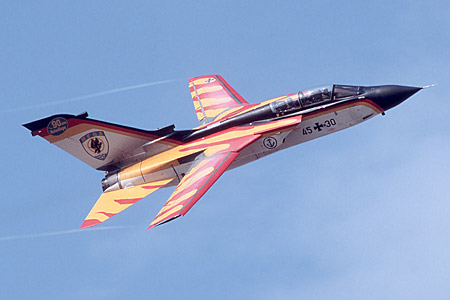Home | Airshows | The Hangar | Nostalgia | Links
|
Shiver
me timbers
|
 |
 |
 |
 |
 |
 |
 |
 |
 |
 |
|
RAF
flair
|
 |
 |
 |
 |
|
Naval
inspection
|
 |
 |
 |
 |
 |
 |
|
Johnny
Foreigner
|
 |
 |
 |
|
Walking
the plank
|
 |
RNAS YEOVILTON AIR DAY, 20 SEPTEMBER
Roger Cook and Andrew Bates wave ahoy from a sunny Somerset.
Photography by Roger Cook/Pynelea Photo Bureau and Mike Kerr
Welcome aboard HMS Heron, better known as Royal Naval Air Station Yeovilton, for the Air Day 2003. Although many old favourites turn up for this display, Yeovilton manages to make this air show their very own with very much a salty, nautical flavour for the event.
The show
celebrated aircraft carrier operations and aircraft of the Royal Navy,
both historic and present day, including a brief glimpse into the future
for the Fleet Air Arm, courtesy of the Harrier GR7 - planned successor
to the Sea Harrier FA2. With assistance from a number of privately owned
historic aircraft of naval origin, 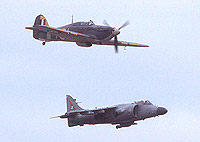 such
as Hellcat, Corsair, Sea Vixen and Wasp, along with their modern day equivalents,
you could almost imagine the heave of the deck and the smell of the sea
air! In fact the weather even attempted to authenticate the nautical theme
with a blanket of fog over most of Somerset during the morning. Very apt,
but most unwelcome. Fortunately, this had burnt off by mid-morning, leaving
the airfield bathed in some beautiful autumnal sunshine for the remainder
of the day.
such
as Hellcat, Corsair, Sea Vixen and Wasp, along with their modern day equivalents,
you could almost imagine the heave of the deck and the smell of the sea
air! In fact the weather even attempted to authenticate the nautical theme
with a blanket of fog over most of Somerset during the morning. Very apt,
but most unwelcome. Fortunately, this had burnt off by mid-morning, leaving
the airfield bathed in some beautiful autumnal sunshine for the remainder
of the day.
In marked
contrast to the excellent flying display, from an enthusiast's point of
view it has to be said that the static aircraft park was sparse in comparison
to previous shows. Admittedly, it is perhaps unfair to pass judgement
based on past events, especially when the purse strings of today are so
much tighter for many air arms. However, the problem is 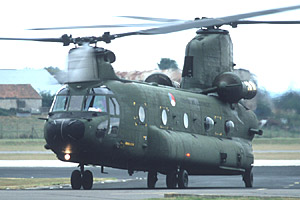 that
one of your scribes has been a regular Air Day attendee since the mid
eighties, and it is very difficult getting used to the sight of so much
empty Yeovilton concrete. Over the years the static park has been filled
with a variety of exotica to delight enthusiasts - who could ever forget
the US Navy 'invasion' of 1996? This has generally been accompanied by
a vast selection of UK hardware, usually dominated by the sharp end of
the Fleet Air Arm, the Sea Harrier. This time, unfortunately, not only
were foreign visitors thinly spread, but the Royal Navy contribution to
the static was also a bit on the lean side. There was only one Sea Harrier
on display, along with a Harrier T8, both from 899 Squadron. With the
'Shar' fast heading towards premature retirement, it was surprising not
to see at least one example from each of the operational squadrons, 800
and 801. Equally surprising was just the one variant of Sea King on show,
whilst the omission of the Merlin literally left a gaping void in the
static park.
that
one of your scribes has been a regular Air Day attendee since the mid
eighties, and it is very difficult getting used to the sight of so much
empty Yeovilton concrete. Over the years the static park has been filled
with a variety of exotica to delight enthusiasts - who could ever forget
the US Navy 'invasion' of 1996? This has generally been accompanied by
a vast selection of UK hardware, usually dominated by the sharp end of
the Fleet Air Arm, the Sea Harrier. This time, unfortunately, not only
were foreign visitors thinly spread, but the Royal Navy contribution to
the static was also a bit on the lean side. There was only one Sea Harrier
on display, along with a Harrier T8, both from 899 Squadron. With the
'Shar' fast heading towards premature retirement, it was surprising not
to see at least one example from each of the operational squadrons, 800
and 801. Equally surprising was just the one variant of Sea King on show,
whilst the omission of the Merlin literally left a gaping void in the
static park.
|
Pieces
of eight
|
 |
 |
 |
|
Coming
astern
|
 |
 |
 |
 |
 |
The planned
photocall on the Friday evening went a little pear shaped because of the
late arrivals of some of the aircraft, but there were still some gems
to be found on this 'Treasure Island'. Despite the slimmed static display,
there were still a number of airframes that commanded the attentions of
the photographers. It was also nice to see the Martin Baker Meteor T7
WA638 in its new all black colour scheme, and the Dutch CH-47D Chinook
(D-663 from 298 Squadron) looked particularly appealing in the sunshine,
parked alongside its AH-64DN Apache stablemate (it would have been nice
to 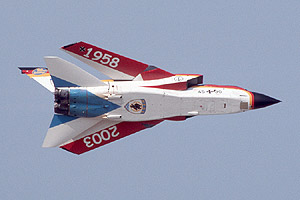 see
an AAC example, but it's obviously a long way from Yeovil to Yeovilton!)
Other highlights included a very polished RDAF CL604 Challenger C-172
from Vaerlose, Polish Navy M-28 Bryza 1R, SHAPE UH-60A Blackhawk and a
pair of German Navy Lynxes (83+19 and 83+21 from MFG3). In fact, the Lynx
proved to be the most dominant aircraft type on display, as the two German
examples were parked in a separate Lynx static, along with half a dozen
Royal Navy machines and an Aeronavale Lynx 808, although this was recalled
back to France during the show once the crew were prised away from the
bar! If that was not enough, Lynx aficionados were in for a further treat.
In light of the above comments regarding the thin static park, the show
organisers most certainly redeemed themselves in the eyes of many enthusiasts
by the simple action of keeping some of the Lynx hangars open for public
inspection. This was an inspired and popular move with both Joe Public
and enthusiast alike, who were especially appreciative. During previous
shows, such hangars have remained firmly shut, which has proved most frustrating
amongst the 'spotter' fraternity, especially as any aircraft checklists
have usually included details of all airframes on site, hangared or otherwise.
Hopefully, this trend may continue for future shows and thus avoid a much-quoted
spotter's phrase; "…..my last Lynx is locked up in hangar 6!? Oh,
b******s!!!!!!!"
see
an AAC example, but it's obviously a long way from Yeovil to Yeovilton!)
Other highlights included a very polished RDAF CL604 Challenger C-172
from Vaerlose, Polish Navy M-28 Bryza 1R, SHAPE UH-60A Blackhawk and a
pair of German Navy Lynxes (83+19 and 83+21 from MFG3). In fact, the Lynx
proved to be the most dominant aircraft type on display, as the two German
examples were parked in a separate Lynx static, along with half a dozen
Royal Navy machines and an Aeronavale Lynx 808, although this was recalled
back to France during the show once the crew were prised away from the
bar! If that was not enough, Lynx aficionados were in for a further treat.
In light of the above comments regarding the thin static park, the show
organisers most certainly redeemed themselves in the eyes of many enthusiasts
by the simple action of keeping some of the Lynx hangars open for public
inspection. This was an inspired and popular move with both Joe Public
and enthusiast alike, who were especially appreciative. During previous
shows, such hangars have remained firmly shut, which has proved most frustrating
amongst the 'spotter' fraternity, especially as any aircraft checklists
have usually included details of all airframes on site, hangared or otherwise.
Hopefully, this trend may continue for future shows and thus avoid a much-quoted
spotter's phrase; "…..my last Lynx is locked up in hangar 6!? Oh,
b******s!!!!!!!"
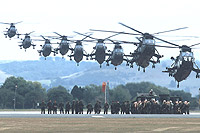 Old
favourites in the flying programme included Boeing B-17 'Sally B' from
Duxford, the Belgian Air Force F-16, a Dutch PC-7 and the AAC Historic
Flight. The flying programme was well supported by the RAF, with contributions
from a 42(R) Squadron Nimrod, 15(R) Squadron Tornado GR4, 1 FTS Tucano,
208(R) Squadron Hawk and 20(R) Squadron Harrier GR7. The RAF Harrier contingent
was especially prominent, as it was to feature in a special flypast to
signify the past, present and future of the Fleet Air Arm. This uniquely
saw Harrier GR7 and Sea Harrier FA2 flying side by side in formation with
the Hellcat.
Old
favourites in the flying programme included Boeing B-17 'Sally B' from
Duxford, the Belgian Air Force F-16, a Dutch PC-7 and the AAC Historic
Flight. The flying programme was well supported by the RAF, with contributions
from a 42(R) Squadron Nimrod, 15(R) Squadron Tornado GR4, 1 FTS Tucano,
208(R) Squadron Hawk and 20(R) Squadron Harrier GR7. The RAF Harrier contingent
was especially prominent, as it was to feature in a special flypast to
signify the past, present and future of the Fleet Air Arm. This uniquely
saw Harrier GR7 and Sea Harrier FA2 flying side by side in formation with
the Hellcat.
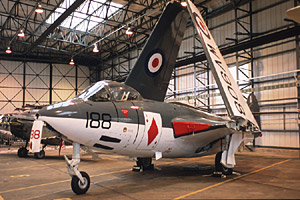 There
were other interesting formations, including three Shars with two Harrier
GR7s, reflecting on things to come with the Yeovilton FAA Squadrons merging
with the units at Wittering and Cottesmore. The German Navy Tornado with
a special MFG2 Anniversary colour scheme ('90 Jahre Marineflieger') really
livened up the afternoon with a scorching display and, always interesting
to watch are the two De Havilland boomers, the Sea Vixen G-CVIX and Vampire
T11 WZ507.
There
were other interesting formations, including three Shars with two Harrier
GR7s, reflecting on things to come with the Yeovilton FAA Squadrons merging
with the units at Wittering and Cottesmore. The German Navy Tornado with
a special MFG2 Anniversary colour scheme ('90 Jahre Marineflieger') really
livened up the afternoon with a scorching display and, always interesting
to watch are the two De Havilland boomers, the Sea Vixen G-CVIX and Vampire
T11 WZ507.
The nautical flavour came from the displays by the four FRADU 'Seahawks', the solo SHAR, the Lynx pair and the Swordfish from the Historic Flight, but this was reinforced by a demonstration of submarine searching by a Merlin ZH852 from 824 Squadron, Culdrose, supported by a pair of Lynx, one Mk3 and one Mk8, while a Nimrod XV245 flew overhead on patrol.
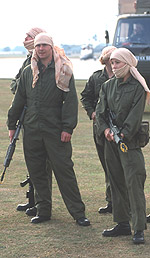
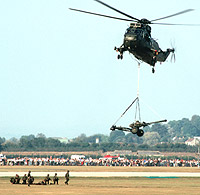 In
true Yeovilton style, the best was definitely saved for last, with the
show culminating in the traditional commando helicopter assault, unmatched
by any other air show in the UK. With a Sea King AEW proving the eyes
above the battlefield and a Lynx and Gazelle acting as FACs, this finale
was as impressive as ever. Sea Kings perpetually offloaded men and machinery,
Sea Harriers 'softened' up the airfield, and an RAF Chinook helped the
airlift task, to the accompaniment of plenty of smoke and noise. All very
impressive, but no doubt about the outcome with victory over the enemy
who obviously came from some obscure Middle Eastern territory! The airshow
season just wouldn't be complete without this spectacle - long may the
tradition continue! Congratulations must go to the Air Show organisers
for a very entertaining show with some imaginative formations and set
pieces - the event just needs a more interesting static park to be really
first-rate.
In
true Yeovilton style, the best was definitely saved for last, with the
show culminating in the traditional commando helicopter assault, unmatched
by any other air show in the UK. With a Sea King AEW proving the eyes
above the battlefield and a Lynx and Gazelle acting as FACs, this finale
was as impressive as ever. Sea Kings perpetually offloaded men and machinery,
Sea Harriers 'softened' up the airfield, and an RAF Chinook helped the
airlift task, to the accompaniment of plenty of smoke and noise. All very
impressive, but no doubt about the outcome with victory over the enemy
who obviously came from some obscure Middle Eastern territory! The airshow
season just wouldn't be complete without this spectacle - long may the
tradition continue! Congratulations must go to the Air Show organisers
for a very entertaining show with some imaginative formations and set
pieces - the event just needs a more interesting static park to be really
first-rate.
With thanks to AHA Events Ltd and Petty Officers Ian Maltman & Darren Clark.
Home | Airshows | The Hangar | Nostalgia | Links
